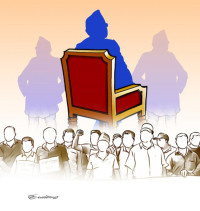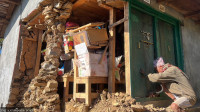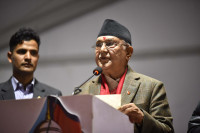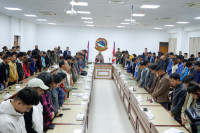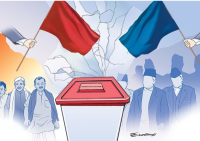Opinion
Nepal, as it was
On two films by Austrian anthropologist Christoph von Fürer-Haimendorf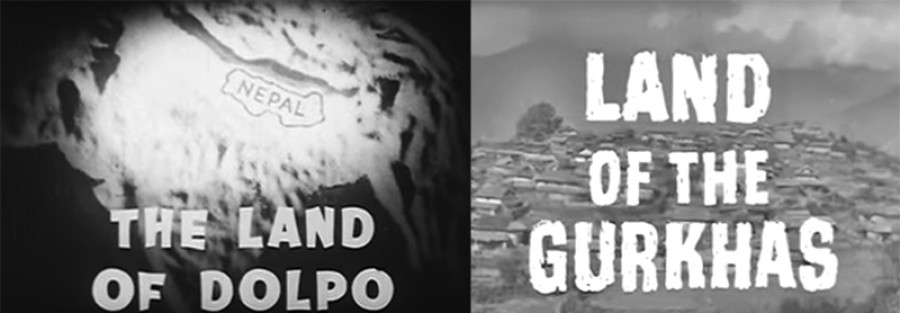
Amish Raj Mulmi
The visuals are surreal. A man hangs upside down from a flimsy rope as he crosses a raging torrent with alacrity and insouciance. As a viewer, you watch in shock and horror, heart in mouth. Then another man does the same, and before you know it, he crosses the river and jumps across the big boulders on the riverbank nonchalantly. The grainy black-and-white footage adds a sense of otherworldliness to the scene. In the voiceover, Sir David Attenborough says in his iconic accent, ‘A single rope, spanning the river, serves the locals as a bridge. But for those unused to acrobatics, it would have been foolhardy to attempt such a crossing.’
A series of reminders
The footage is from a crossing on the Arun river in 1957, when Austrian anthropologist Christoph von Fürer-Haimendorf and his wife walked from Gorkha to Darjeeling via Kathmandu, the Khumbu region and the Arun valley. Haimendorf’s footage found its way into a documentary called Nepal: Land of the Gorkhas, which was narrated by Attenborough. The short half-hour film, available on YouTube, is an extraordinary visual treat in several ways. It gives us a glimpse into the many cultures and ethnicities Haimendorf and his wife came across during their months-long expedition across half of Nepal. At the same time, it’s also a reminder of what Nepal used to be like, how its people lived, and how far we’ve come since those days. After all, 1957 isn’t so far off into the past, yet, to watch a boy of 13 get married off to a girl ‘several years older’ than him in a Rai village reminds you that our cultures have evolved far beyond what they used to be like.
A friend introduced me to this footage after I returned from a trip to Humla and remained disoriented by the sounds of the city after two weeks of silence. I found it a curious throwback to my time in Humla, for some of the cultural practices, such as a Sherpa dance, were not too dissimilar from what I had seen in Limi valley. Some of the houses in Simikot even today bear more than a passing resemblance to the homes seen in the documentary. But more interestingly, the footage had been shot by Haimendorf, who was the first western anthropologist to work in Nepal.
A visual record
Haimendorf was an Austrian scholar who came to the Indian subcontinent in the 1930s, first to research the Naga tribes of north-east India. During his second research trip, the Second World War broke out, and because of his German passport, he was interned by British authorities in Hyderabad. Here, too, he researched into the tribal populations of the Chenchus, Reddis and Raj Gonds.
In 1953, Nepal was opened up to outsiders, and Haimendorf arrived in Nepal to study the Sherpas first. As anthropologist Dor Bahadur Bista, who was his research assistant, would later recall, ‘[W]hen I found Haimendorf, I went to him and said, "I will be glad if you allow me to come with you; my advantage will be that I will be looking into my own country, my own society, and not just with one pair of eyes and one pair of ears but with the added pair of eyes and ears of a professor of London University of the reputation which you have. And in return, I'm willing to do anything, whatever you want me to do." That's how I offered my services. But from his point of view, he was looking for an assistant/informant, and I fit into that role.’ Haimendorf would go on to research about the Thakali merchants of Tukuche and the Mugu-Humla traders in Karnali and write a comparative study called Himalayan Traders in 1975, still available in bookshops in Kathmandu today. Together with his wife, he shot footage not just for the 1957 documentary, but also for another film on Dolpo in 1962, one on Sherpas in 1971, on whom he also produced a monograph in 1964, and another on trading caravans of north-west Nepal.
The Dolpo film is another excellent visual record of how Nepal used to be. Voiced-over by Alexander John, it begins with the Haimendorfs travelling to Tukuche on the caravan route. ‘Five measures of salt for six of barley,’ John says, referring to the salt-for-grains barter rates at the time. Dolpo at this time had seen an influx of Tibetan refugees escaping Communist China, and the Haimendorf party meets a group of them. They enter a Dolpo village at a time when a quarrel has everybody’s attention: ‘A girl who had several lovers had suddenly left her parents’ house and got married without consulting anyone. Such an unorthodox behaviour was a slight on her family.’
A 'colonial professor'
While reading about Haimendorf, I came across the aforementioned interview by Bista, which broke down his relationship with the Austrian scholar. From the little context I had, it seemed as though there were intellectual differences over the ownership of the knowledge the two had collected during their field visits. ‘He had specifically told me at one point that I would not be allowed to publish anything in English, although he would not mind my publishing in Nepali, because all the information I had collected was under his copyright,’ Bista told his interviewer.
Bista had been an invaluable part of Haimendorf’s research, yet the latter didn’t think Bista would ‘make a student of anthropology’. Knowing Bista’s excellent work in defining Nepali cultures, we’ll reject that statement in its entirety, yet Bista’s interview provides excellent insight into academic conflict, and the idea that whether a non-native scholar can truly understand the complexities of a native culture. However, to be fair to Haimendorf, Bista too acknowledges that he was ‘shocked’ in the beginning of his research into the Sherpas because of his own urban background. But he suggests Haimendorf was ‘a colonial professor’, and his experiences with the Austrian convinced him ‘there was no room for the discipline in Nepal if we were only going to mimic European schools of anthropology.’
The conflict with Bista aside, Haimendorf’s study of Nepal was a pioneering one. Reading the section on Humla in Himalayan Traders, it is evident that he missed out on a few cultural markers, such as the trade in wooden bowls that another scholar, Melvyn Goldstein, in 1975 wrote was significant for upper Humla’s economy. That should not however take away from his anthropological work, which was significant and opened the gates for other scholars to study Nepal. These two short films, in addition, allow us to see a Nepal that many of us aren’t familiar with. The rural idyll is demolished by his seen-as-is footage; it is not a Nepal many would wish a return to: remote, without any modern infrastructure, and closed off to new ideas. One could argue against the ‘tragedy of the commons’ line of thought he pursues –the idea that natural resources were being exhausted by rural populations–but it was an idea that had caught much attention at the time.
Today, the two films are a testament to what Nepal once was like. Equally importantly, they are also a reminder of the scholarship that has been carried out in Nepal in the past decades, and why it’s essential for such scholarship to remain available outside academic circles to the general readership.
Mulmi can be followed on: @amish973




 13.12°C Kathmandu
13.12°C Kathmandu
